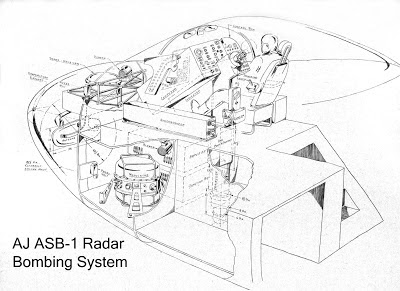The implication is that there were TBF/Ms configured for passenger transport during World War II. If so, I haven’t seen any photographic evidence of one in service or a designation change to denote that configuration. However, there is a photo dated 17 April 1944 from Grumman’s files of two side-by-side, forward-facing seats mounted inside the turret ring.
In any event, there were lots of TBMs left over after World War II so some were repurposed specifically for Carrier On-board Delivery, or COD and designated TBM-3R.
The gun turret was removed (note that the mounting ring remained in place as it was part of the primary structure) along with other mission equipment and seats were added.
The canopy was extended over the tail gunner's position. Two seats were installed in the compartment aft of the pilot and two in the former turret area. Two seats were also provided in the former radioman compartment below the turret area for a total of six passenger seats. One was usually occupied by the load master/crew chief, leaving the other five available for passengers.
There were at least three difference variations of the canopy modification incorporating different amounts of sheet metal but the cabin access remained the same:
A basket was installed in the bomb bay for cargo.
Rick Morgan reports that the conversions were first used in early 1951 for transport of urgent cargo (spare parts, etc.) and personnel to the carriers off Korea as reported in the July 1951 edition of Naval Aviation News. According to his search of allotment records, approximately 27 TBM-3Rs were created; most were assigned to VR (air transportation) squadrons worldwide. In July 1954, for example:
VR-5 (RS) San Diego, California 4
VR-22 (RB) Norfolk, Virginia 6
VR-23 (RK) Atsugi, Japan 8
VR-24 (RD) Port Lyautey, Morocco/Naples, Italy 7
Although one mission proposed for the multipurpose Douglas AD-5 was COD, the TBMs were all replaced in the Navy VR squadrons by the Grumman TF-1 (C-1) by January 1957. See http://thanlont.blogspot.com/2011/05/carrier-onboard-delivery.html
The gun turret was removed (note that the mounting ring remained in place as it was part of the primary structure) along with other mission equipment and seats were added.
The canopy was extended over the tail gunner's position. Two seats were installed in the compartment aft of the pilot and two in the former turret area. Two seats were also provided in the former radioman compartment below the turret area for a total of six passenger seats. One was usually occupied by the load master/crew chief, leaving the other five available for passengers.
There were at least three difference variations of the canopy modification incorporating different amounts of sheet metal but the cabin access remained the same:
A basket was installed in the bomb bay for cargo.
Rick Morgan reports that the conversions were first used in early 1951 for transport of urgent cargo (spare parts, etc.) and personnel to the carriers off Korea as reported in the July 1951 edition of Naval Aviation News. According to his search of allotment records, approximately 27 TBM-3Rs were created; most were assigned to VR (air transportation) squadrons worldwide. In July 1954, for example:
VR-5 (RS) San Diego, California 4
VR-22 (RB) Norfolk, Virginia 6
VR-23 (RK) Atsugi, Japan 8
VR-24 (RD) Port Lyautey, Morocco/Naples, Italy 7
Although one mission proposed for the multipurpose Douglas AD-5 was COD, the TBMs were all replaced in the Navy VR squadrons by the Grumman TF-1 (C-1) by January 1957. See http://thanlont.blogspot.com/2011/05/carrier-onboard-delivery.html



















